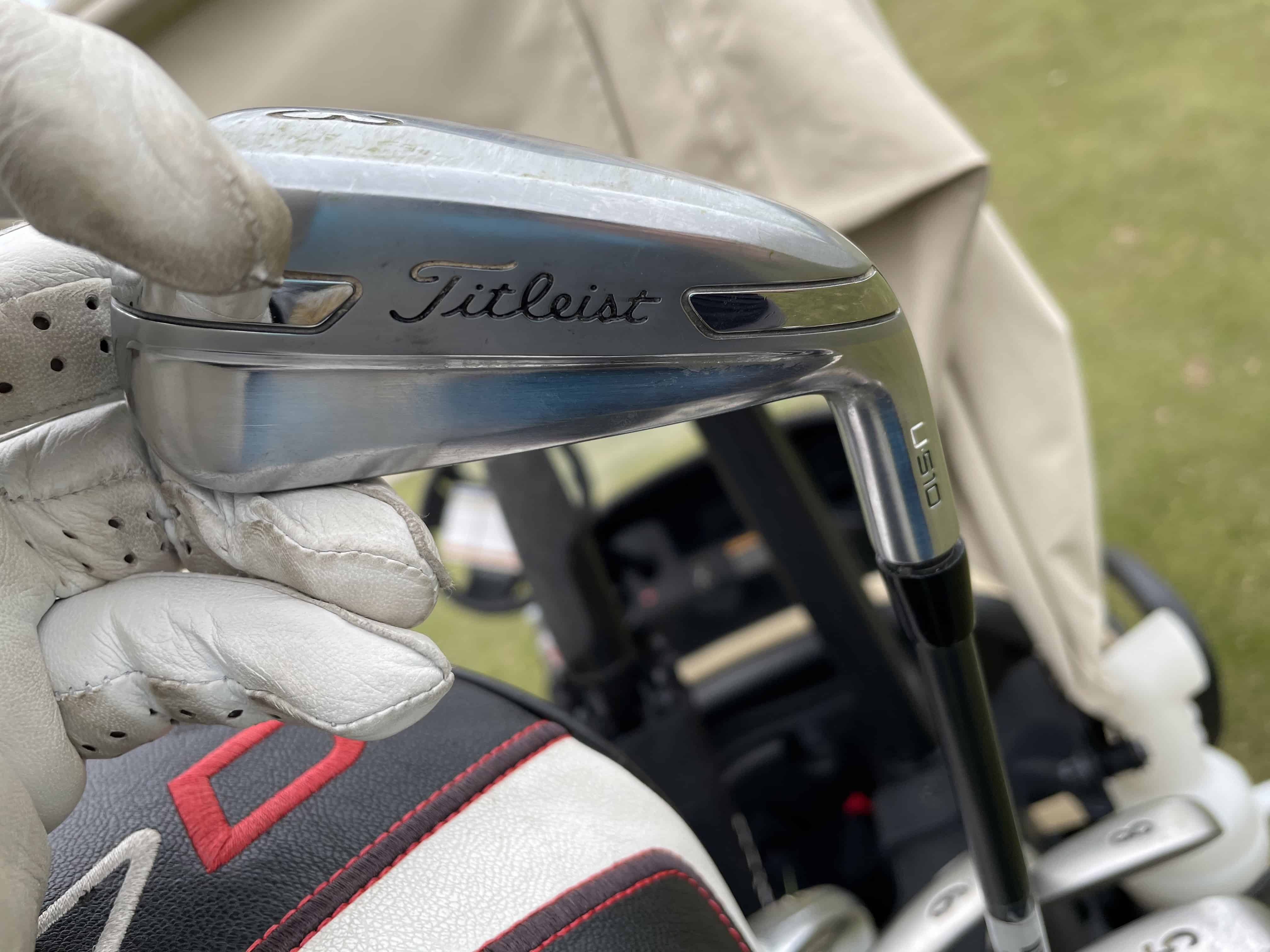There are many options out there for golfers when it comes to the longer clubs in a bag.
Some golfers carry all or some of the following:
- Driver
- Fairway Woods
- Hybrids
- Driving (Utility) Irons
- Long Irons
It can be confusing to know which ones to carry and when to hit each one. A typical golf bag might consist of one of the following setups:
- Driver, 3 wood, driving iron and irons
- Driver, 3 wood, hybrid and irons
- Driver, hybrid, driving iron and irons
Whatever setup you have, we are here to help you decide the best times on when to use a driving iron. I personally have the first setup and have gone with the driving iron and have eliminated the hybrid.
Resource: Utility Iron vs Hybrid: Which one should I carry?

When To Use a Driving Iron: 3 Key Situations
- Off the tee on a narrow or short par 4
- The 2nd Shot on a Par 5
- On a long par 3
These are the top 3 situations when golfers will most likely use their driving irons. The benefits of the driving iron is that it is accurate, has a low spin rate and you can control the height of the shot like a regular iron. These three benefits help you be more aggressive and hit higher quality shots with the three situations listed above.
When To Use A Driving Iron
Situation 1: Off the tee on a narrow or short par 4
We have all been there!
We are standing on the tee of narrow par 4. We know that all we need is a ball in the fairway for a chance to hit a wedge on the green and a possible birdie and a guaranteed par. However, the trees are hanging over the edges and it is an intimidating tee shot with the driver or even a 3 wood. There is even a fairway bunker to add to the difficulty.
This is when you will be glad that you have a driving iron in your bag.
Scenario 1: You grab the driving iron, step up to the shot and split the middle of the fairway. You head up to the ball and hit your approach shot on and have a bridie putt 20 feet or less. You have managed your game, kept your swing online and now have a chance for birdie. You can leave the green with a positive feeling.
Scenario 2: The alternative is to grab the driver and try to hit a shot that you are not comfortable hitting. You tense up and hit a poor driver, leaving you in the trees and starring at a bogey or worse unless you are good at scrambling for your par!
The driving iron is a game changer on these short, score-able par 4s. Grab the driving iron, swing with confidence and get the ball into play. If you can hit your wedges, you will maintain your confidence and keep the positive momentum in the round going!
Resource: Driving Iron vs 3 Wood: Which one should I carry?

Situation 2: The 2nd shot on a par 5
Here is another situation many of us face at least 4 times per round. It is a par 5 and you have hit a quality drive. You are left in the range somewhere between 200 and 275 yards depending on the length of the hole. This another great time to have your go to driving iron that helps with accuracy, but gets some impressive distance with the lower spin rates and the penetrating ball flight.
Scenario 1: You are standing there at 230 yards. This might be a little short for your 3 wood and a bit long for your driving iron, but you go withe driving iron because of the accuracy and the potential to get there. You make a confidence swing and send the ball flying. You get a good bounce or two and end up on the green or with a simple chip. The confidence in the accuracy of the
driving iron allowed to make a comfortable, yet aggressive golf swing resulting in a positive outcome. You give yourself a chance for birdie and at worse, make your par.
Scenario 2: You are standing there are 230 yards. You go with the 3 wood and hook the ball because you weren’t confident and stalled your swing. You end up 35 yards from the green behind a tree or in the bunker. You have to scramble for your par and have no chance for a birdie.
Once again, we have all faced these situations, if you can make consistent, solid contact with the driving iron, you will soon love the club and rely on it frequently on the par 5s.
Back to scenario 1, if you were to punch a low, penetrating shot down the fairway and leave yourself with a 30 yard pitch shot to set up a short birdie putt you really have taken a safe route by hitting the 200 yard running low shot where the accuracy is incredible.
The low spinning shot will penetrate and run out and all you had to do is make a simple 3 quarter punch shot swing. Almost guaranteed to fly straight and accurately.
The overall versatility of the club is impressive and worth having in your bag!
Resource: Utility Iron vs Long Iron (Difference Explained)

Situation 3: On a long par 3
It seems like most golf courses have a par three that is 200 yards plus. I often dreaded these holes because I lacked confidence in the hybrid because of the fear of over drawing it left or hitting a pulled shot.
The driving iron has given me better accuracy because of the iron technology and the overall weight of the club. Once again, we will take you through two scenarios.
Scenario 1: You step up to a 215 yard par 3. This hole is too long for your 4 iron and too short for your 3 wood. You go with the driving iron and keep the ball around the green. Being realistic you know that even the pros have about a 30-40 foot proximity to the pin and you are happy with any shot on the green.
You step up to the shot knowing you have enough club and the accuracy to keep the ball at worse around the green. You hit a quality shot and have a putt or some sort or a simple chip shot where you can save par at least 75% of the time.
Scenario 2: You step up to the same hole, but try to swing your hybrid. You end up over drawing and get yourself in trouble with a hazard, trees or something other barrier. You end up with a bogey or worse and lose your momentum.
Having the right club for these longer par 3s is essential. Practicing these shots will help you not lose out on these difficult holes and give yourself the best chance to make a par!
Resource: Utility Iron vs Hybrid: Which one should I carry?

Measure What Is Best For Your Game
I would highly recommend a portable launch monitor to measure what is best for your game. Many golfers will need some testing to determine if a fairway wood, hybrid or driving iron is best for their bag and their game.
I prefer the fairway wood and driving iron combination, but for many the fairway wood and hybrid is a great combination. Most of these will come down to your swing speed, launch angle and overall carry distance.
Here are three launch monitors that I would recommend (Between 500 and 2000 dollars):
Resource: Where can I use a launch monitor (3 options)
Many of the lower handicap, higher swing speed players would benefit from the driving iron because of the accuracy and not having the fear of the overdraw.
Mid to High Handicap players with a slower swing speed (driver under 100 miles per hour) will more than likely prefer the hybrid. The ability to launch the ball higher and further will help on many of the scenarios above.
With a portable launch monitor, you can have instant data on your shots that includes:
- Ball Speed
- Carry Distance
- Launch Angle
- Spin Rate
- Spin Axis
I like to monitor all of these data points and have found the spin axis (side spin) on my golf shots to be lower with my driving iron when compared to my hybrid. This gives me greater confidence in the accuracy of the club. I also have a lower spin rate with similar ball speed which results in greater distance on those reachable par 5s. Overall, I find the driving iron to be highly verstaily in the shots I have to hit during a round of golf!

Final Thoughts: When To Use A Driving Iron
I believe you will find the driving iron to be more than just a “driving” club. The overall accuracy and confidence when standing over any of thee shots listed above is a game changer. You can now play with confidence from this distance!
Make sure you measure your important data and have a way to see how the club and ball are interacting. If you visit any PGA Tour even you will find plenty of golfers utilzing launch monitors. While I understand not everyone can afford a Trackman there are some great alternatives.
Get Started Today!
I am an amateur golfer on a journey to get better, enjoy the game as often as possible and share my passion and knowledge with others. I have coached high school golfers at a high level and have a great passion for the game and want to give back. I enjoy learning about the golf swing and am currently studying to be a certified professional golf instructor. Join me in our journey to get better everyday. Thank you for reading!

